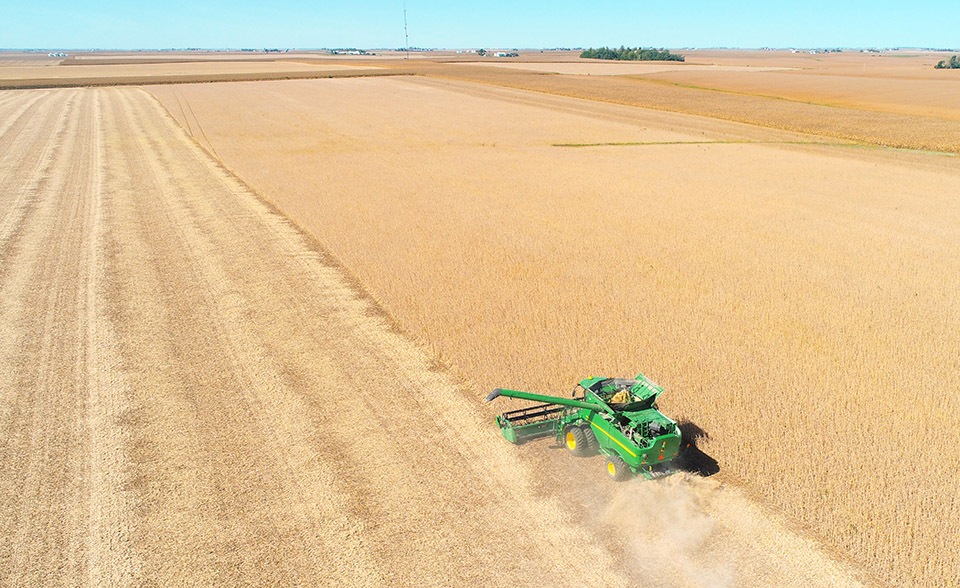
(Photo: Iowa Soybean Association / Joclyn Bushman)
5 key takeaways following August’s WASDE report
August 17, 2023
The USDA released its monthly World Agricultural Supply and Demand Estimates (WASDE) report Friday and it is the first report of the year incorporating survey-based yield estimates. Following the report’s release, U.S. Soybean Export Council CEO Jim Sutter hosted an online podcast alongside Todd Goll, market research analyst of The Matthews Group at Marex, to quickly offer same-day reaction and analysis to a few of the surprises held in the report surrounding the soybean industry.
1. The August WASDE is an exercise in balancing perception against reality
An estimate is just that: an estimate. Goll says the real-world realities of the weather and market demand are two unknowns that could change the direction from where estimates are today.
“[Balancing perception and reality is] difficult to do,” Goll says. “The perception is we still have a crop in the field, that we still need to have timely rains and temperatures that will benefit the crop, more beans in August but we’re still finishing out corn as well. The reality is, that these are the numbers we will trade for the next 30 days until we get to the September WASDE. So we’re trying to balance those two things right now.”
2. Estimated U.S. soybean production and yields fall 2% from July
The Aug. WASDE report lowered U.S. soybean production by 95 million bushels to 4.2 billion bushels (or 114.5 million metric tons) and an expected yield of 50.9 bushels per acre, down 1.1 bushels per acre from July’s report. Harvested acres for soybeans remained unchanged, at 82.7 million acres.
“That 50.9 [yield] was under the average guess but was within the range of guesses,” Goll told Sutter during the USSEC podcast. “That again comes to the perception work. This was a surveyed crop; it was not a crop where they went into the fields other than to maybe look at some populations. There was not pod counts. A lot of that was based on the survey done in the last week of July, that was before a lot of those August rains came in. The other piece of perception is the assumption that 52 was trendline yield. We just don’t know on yield at this point. The weather forecast we’ve had in the first part of August, the forecast that we have in the next week to 10 days looks positive for a number of different rains across the belt.”
3. U.S. season-average soybean prices trend up from July
The WASDE’s forecast for U.S. season-average soybean prices ticked up slightly for August, to $12.70 per bushel, up $.30 from July. The price of soybean meal increased $5 to $380 per short ton and soybean oil to $.62 per pound, an increase of two cents.
4. Exports marked lower, but a global “demand story” appears
U.S. exports of soybeans were reduced by 25 million bushels from July’s estimate to 1.825 billion bushels. Goll says the reduction was a surprise to him, and explained a developing global “demand story” he sees unfolding.
“In the last three to four weeks China is showing up and they’re showing up not just for Brazilian beans, they’re showing up for U.S. beans, they’re showing up for Argentine beans,” says Goll. “It is the state-owned crusher that’s coming in to buy, it is the private crusher that’s coming in to buy, and just as important it’s the state reserve that’s coming into buy. The state reserve has been very aggressive in for buying U.S. beans for August and September, buying October, November beans; buying February U.S. beans and buying May Argentine beans.
He continued, “Generally speaking the state reserve does not buy Brazilian beans because of the high moisture content, as these beans are deemed for storage for some period of time. So, all of a sudden, you’ve got this demand play coming in and you can ask why? China’s crush margins are as good as they’ve been in a long time.”
5. Multiple states expected to break soybean yield records in 2023
Released at the same time as the August WASDE, the August Crop Production Report from USDA’s National Agricultural Statistics Service (NASS) shows expectations for many soybean growing states to Iowa’s east and south having their best year ever for yield. The report earmarks Iowa at 58 bushels per acre yield which would be just shy of 2022’s 58.5 bushels per acre and Iowa’s current record from 2021 at 62 bushels per acre. Some of the states expected to break their records for soybean yield in 2023 are Arkansas, Indiana, Ohio, Mississippi and the Carolinas.
Back